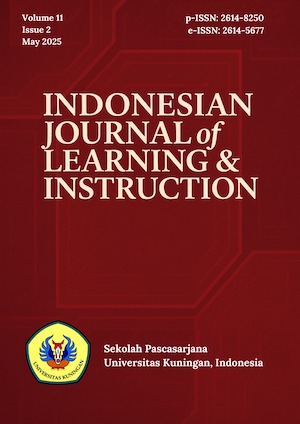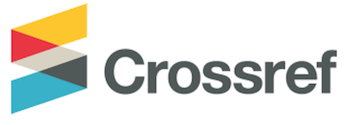EFL STUDENTS’ PREFERENCE IN RECEIVING WRITTEN CORRECTIVE FEEDBACK
Abstract
One solution to help EFL (English as a Foreign Language) students in writing skill is providing a written corrective feedback by a teacher. Somehow, it is also necessary for a teacher to know the appropriate feedback given to their students. This study had two purposes: 1) To describe the students’ thought toward feedback strategies with different proficiency levels in general and in specific writing aspects content; and 2) To explore the most students’ preference with different proficiency levels in general and in specific writing aspects content and form. A qualitative data analysis approach was integrated using an interview, eight students in total were chosen to be interviewed; two from each group and level (two-high, two low direct feedback with an end note and two-high, two-low indirect feedback with an end note). N vivo was used to analyze the content analysis of the data. The study found that no matter low or high proficient writers, they had a positive attitude toward the teacher’s feedback and most of them preferred to receive direct corrective feedback to improve their writing performance both in content and form. In brief, providing a feedback is needed for students however it must be advisable with students’ proficiency level in order to make them easier in understanding the feedback.References
Ahmadi, D., Maftoon, P., & Mehdrad, A. G. (2012). Investigating the effects of two types of feedback on EFL students’ writing. Procedia Social and Behavioral Sciences, 46, 2590-2595.
Alfaki, I. M. (2015). University students’ English writing problmes: Diagnosis and remedy. International Journal of English Language Teaching, 3(3), 40-52.
Aridah, A., Atmowardoyo, H., & Salija, K. (2017). Teacher practices and students’ preferences of written corrective feedback and their implication on writing instruction. International Journal of English Linguistics, 7(1), 112-125.
Biber, D., Nekrasova, T., & Horn, B. (2011). The effectiveness of feedback for L1-English and L2 writing development: A meta-analysis. TOEFL iBT TM Research Report.
Bitchener, J. (2012). A reflection on the ‘language learning potential’ of written CF. Journal of Second Language Writing, 21, 348-363.
Black, D. A., & Nanni, A. (2016). Written corrective feedback: preferences and justification of teachers and students in a Thai context. Journal of Language Studies, 16(3), 99-114.
Chen, S., Nassaji, H., & Liu, Q. (2016). EFL learners; perceptions and preferences of written corrective feedback: a case study of university students from Mainland China. Asian-Pacific Journal of Second and Foreign Language Education, 1(5), 1-17.
Creswell, J. W. (2012). Research design qualitative, quantitative, and mixed methods approaches second edition. United States of America; Sage Publication.
Daneshvar, E., & Rahimi, A. (2014). Written corrective feedback and teaching grammar. Procedia - Social and Behavioral Sciences,136, 217–221.
Fareed, M., Ashraf, A., & Bilal, M. (2016). ESL learners’ writing skills: Problems, factors and suggestions. Journal of Education and Social Sciences, 4(2), 81-92.
Farrokhi, F., & Sattapour, S. (2011). The effects of focused and unfocused written corrective feedback on grammatical accuracy of Iranian EFL learners. Theory and Practice in Language Studies, 1(12), 1797-1803.
Guénette, D., & Lyster, R. (2013). Written corrective feedback and its challenges for pre-service ESL teachers. Canadian Modern Language Review, 69(2), 129-152.
Hashemnezhad, H., & Mohammadnejad, S. (2012). A case for direct and indirect feedback: the other side of coin. English Language Teaching, 5(3).
Horbacauskiene, J., & Kasperaviciene, R. (2015). Learners’ preferences towards corrective feedback in writing assignments in tertiary education. Explorations in English Language and Lingustics, 3(2), 70-83.
Irwin, B. (2017). Written corrective feedback: Student preferences and teacher feedback practices. IAFOR Journal of Language Teaching, 3(2), 35-58.
Sayyar, S., & Zamanian, M. (2015). Iranian learners and teachers on written corrective feedback: How much and what kinds? International Journal of Educational Investigations, 2(2), 98– 120
Tursina, P., & Chuang, M. (2017). Direct and indirect corrective feedback on EFL students’ performance. Proceedings of the 1st English Education International Conference (EEDIC) in conjunction with the 2nd Reciprocal Graduate Research Symposium (RGRS) of the Consortium of Asia Pacific Education Universities (CAPEU) between Sultan Idris Education University and Syiah Kuala University. Banda Aceh, USK.
Van, B. C., De Jong, N. H. and Kuiken, F. (2012). Evidence on the effectiveness of comprehensive error correction in second language writing. Language Learning, 62(1), 1-41.
Westmacott, A. (2017). Direct vs. indirect written corrective feedback: Student perceptions. Ikala, Revista de Lenguaje y Cultura, 22(1), 1-20.









